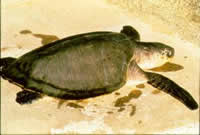Olive ridley turtle (Pacific ridley)

Common name: olive ridley turtle (Pacific ridley)
Scientific name: Lepidochelys olivacea
Family: Cheloniidae
Description
Olive ridley turtles are grey or olive-grey above, usually without any conspicuous markings and whitish below. Their head is large and massive. The carapace (shell) is broad and heart-shaped, usually with six or more costal scales. They can grow to a total length of 1.5m. Their hatchlings are blackish above and dark brown below.
Habitat and distribution
Olive ridley turtles occur in shallow, protected waters, especially in soft-bottomed habitats. They are distributed across the tropics but are rarely found around oceanic islands. Major breeding aggregations occur in Mexico, the west coast of Costa Rica, in Surinam, and the east coast of India. In Australia, they occur along the coast from southern Queensland and the Great Barrier Reef, northwards to Torres Strait, the Gulf of Papua, Gulf of Carpentaria, Arafura Sea and Joseph Bonaparte Gulf in Western Australia. Low density nesting has been recorded at a limited number of sites over recent decades. Within Queensland, breeding is known only from isolated nesting sites at five locations within the Gulf of Carpentaria: Crab Island, Edward River, north of Weipa, Scrutten River mouth and the Wellesley Islands.

Life history and behaviour
No large rookeries of olive ridley turtles have been recorded in Australia. Olive ridley turtles nest all year round, although most nesting occurs during the dry season from April to November. Females lay on average 109 large round, parchment-shelled eggs. Hatchlings emerge from the nests about two months after laying.
Threatening processes
All marine turtle species are experiencing serious threats to their survival. The main threats to the olive ridley turtles are climate change, marine debris entanglement and terrestrial predation of eggs and hatchlings (Cape York population). Other threats include domestic fisheries bycatch and chemical and terrestrial discharge (Northern Territory population).
Recovery actions
A national Recovery plan for marine turtles in Australia exists and identifies the management actions necessary to recover marine turtle species in Australia.
Management to conserve this species include:
- Reduce the impacts from marine debris through improved source reduction, collection and management – particularly ghost nets.
- Minimise chemical and terrestrial discharge through best practice industrial, urban and agricultural run-off and stormwater management
- Reduce impacts of terrestrial predation through targeted predator control programs
- Reduce domestic fisheries bycatch through best practice and continued innovation of turtle bycatch mitigation in all Australian fisheries.
- Invest in climate change research and monitoring programs to assist adaptive management of likely climate change impacts.
How you can help
You can help this species by:
- Report sick, injured, dead and/or tagged marine turtles to 1300 130 372. A Queensland Government officer in the relevant region will be contacted with your information and will determine the appropriate response.
- Remember that rubbish you throw away can find its way to the sea, where turtles can mistake things such as plastic bags for jellyfish. Plastic swallowed by mistake can cause blockages of the stomach and intestines of marine animals such as turtles.
- Follow the regulations relating to "go slow areas for turtles and dugong" including operating vessels off the plane and not undertaking motorised water sports. Many turtles are struck by propellers of speeding boats and this can cause injury and death.
- Be careful not to damage seagrass by careless anchoring or operating of a vessel in shallow water where boat wash or propeller damage can occur.
- Take care when fishing. Don't leave behind discarded fishing lines and don't use stainless steel hooks.
- Check crab pots regularly. Set your pots to avoid loose rope floating about in the water and ensure your pot entrances are not large enough to trap a turtle. Familiarise yourself with the guidelines on how to make a new crab pot, or learn how to correctly modify an existing one
- Pick up marine debris from the beach and waterways and report ghost nets to your local ranger.
Related information
- Carpentaria Ghost Net Programme
- Department of the Environment and Energy (DOEE) 2017. Recovery plan for marine turtles in Australia. DOEE, Canberra.
- Department of the Environment and Energy (DOEE) 2017. Lepidochelys olivacea, Olive Ridley turtle (Pacific Ridley turtle): in Species Profile and Threats Database. DOEE Canberra.
- Limpus, C. J. (2008). A Biological Review of Australian Marine Turtles. 4. Olive Ridley Turtle Lepidochelys Olivacea (Eschcholtz). (Queensland Government Environmental Protection Agency: Brisbane.)
- Queensland Parks and Wildlife Service 2016. Queensland Marine Turtle Field Guide . former Department of National Parks, Sport and Racing, Brisbane.


